Leaf cutter ants are becoming a very common threat in residential settings, especially in the southern United States. They are a major problem for agricultural fields, property yards, gardens, and leaf cutter ants even sometimes invade our houses.
To get rid of leaf cutter ants use a non-repellent insecticide to spray the affected vegetation, trails, and mounds. Inspect your property often and look for mounds before they become large and difficult to handle.
In this complete guide, you will learn everything you need to know about leaf cutter ants, how to identify them and find their mounds, and how to get rid of them in case of an infestation. Let’s start!
Everything You Need To Know About Leaf Cutter Ants
Leaf cutter ants are native to South and Central America but are also common in some parts of the southern USA. They are also known as parasol ants because they often carry leaf pieces over their head like mini umbrellas.
What Do Leaf Cutter Ants Look Like?
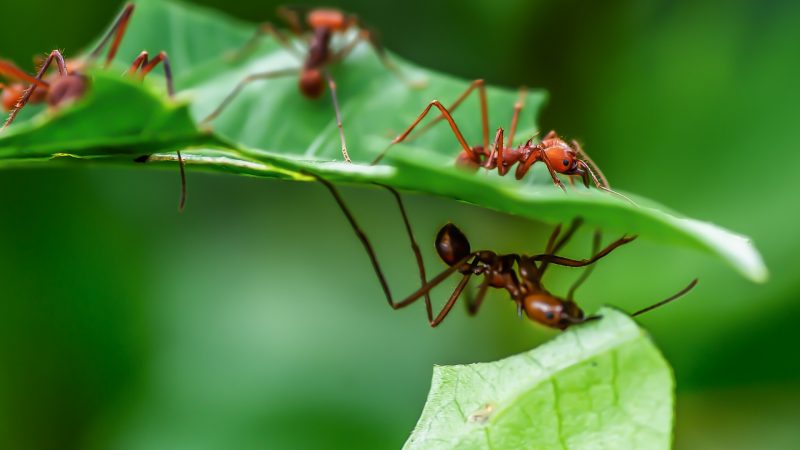
Leafcutter ants vary in size depending on their castes (workers, reproductive females, and males). Workers are ranged between 1.5 to 12 mm (1/16 to 15/32″), queens are 24 mm (15/16″) long whereas males are 13 to 18 mm (33/64″ to 45/64″) long.
Reproductive males have darker bodies with brownish wings and are larger in size when compared to worker ants. They usually have orange or dark brown to reddish black bodies with pale abdomen and legs. The legs of the leaf cutter ants are long and spiny.
Reproduction of Leaf Cutter Ants
The single colony of the leaf cutter ants may be comprised of up to 5 fertile females or queens which help in the survival and establishment of the colony by producing eggs.
The eggs later develop into larvae (cream in color) which turn into sterile workers and winged reproductive males in the spring season. When the queen lays eggs the sterile worker support larvae with everything they need.
An established colony of the Texas leaf cutter ants can contain up to 100,000 ants (mostly sterile female workers). These ants are divided into different castes depending on their size and the type of work they do. These are the following groups of leaf cutter ants: majors, mediae, minors, and minims. Their queen’s life span is about 10 years or more.
What Do Leaf Cutter Ants Eat?
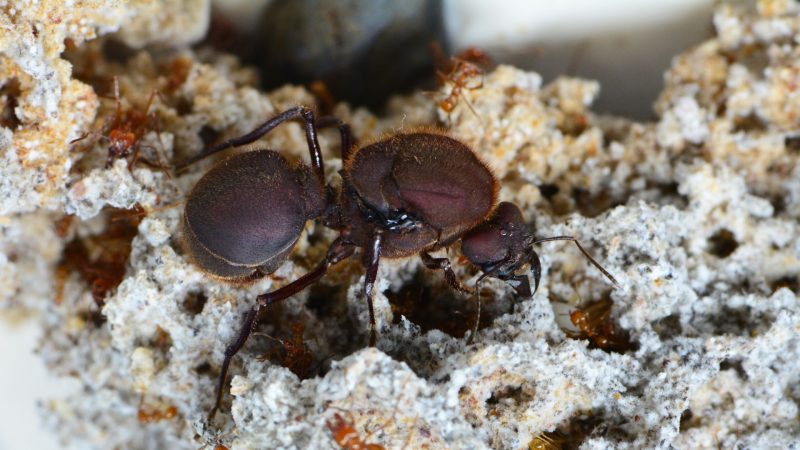
Leafcutter ants do not actually eat the leaves but carry them to their underground nesting area. Then the leaves are chewed into a pulp which produces a fungus. This fungus, produced from the pulp of the leaves in the so-called fungi garden is what feeds the ant larvae and the colony. Leaf cutter ants have a special type of bacteria living on their skin that helps them fight invading pests and it also protects their fungus.
The Leaf Cutter ants can infest fruit trees or nut trees and different ornamental plants for leaf clipping. They have a strong and efficient jaw that can vibrate 1000 times per second in order to quickly cut the leaf. Each ant has the ability to carry foliage 20 times heavier than its body weight. After cutting the leaves or needles, they carry them to their nests and chew them into pulp to create the “fungus garden”.
This specific type of fungi is Lepiotaceae, genus; Leucoprinus, or Leucoagaricus (known as leucocoprinaceous fungi). Leafcutter ants get nourishment from fungal bodies (containing protein) known as gondylidia. The workers feed on the plant sap whereas larvae depend on fungi for their survival. The leaf-cutter ants are attracted to buildings and residences due to light or vegetation.
Related: What Do Ants Eat? | Ant Feeding Habits
Where Do Leaf Cutter Ants Live? | Leaf Cutter Ant Nest
The leaf cutter ants build their mound in different habitats wherever they find soil such as meadows, sidewalks, woody areas, fields, gardens, and yards. They can extend their mound in the area up to 100 sq ft and can go deep up to 12 ft into the ground.
Different chambers are assigned to the young and adult ants according to their size and the function they perform. They have an effective waste management system to prevent the growth of parasitic fungi in the nest that can affect the food sources. Worker ants transport waste outside the mound, help in the decomposition process and produce amino acids and enzymes.
These ants love moisture and tend to build their nests in loamy or well-drained soil, for example, near streams, ditches, and creek beds. Their underground nests are massive structures with a complex network of tunnels, different chambers, various exits, and entrances.
Each colony consists of different types of ants – the queen is the founder and carries a piece of fungus from the old colony to start the new one. The workers are sterile females responsible for the leaf supply and the production of fungus, as well as protection.
When it is time to move into a new colony, the queen lays special kinds of eggs that become fertile males and females. These fertile ants have wings so they can fly away to the new territory and start mating there. After mating, female leaf-cutter ants lose their wings and become queens, while male ants simply die.
Leaf Cutter Ant Behavior
One of the very peculiar behavioral characteristics of the leaf cutter ant is when a queen builds a nest and workers develop. The workers immediately start seeking for plants to bring back to the colony.
The fungus that grows inside the nest is what the leaf cutter ants depend on to stay alive. The fungus is consumed by all species of ants in the colony and is grown over time thanks to the decomposition of the foliage and the workers’ saliva.
Throughout the summer, a constant stream of employees gathers leaves and pieces, which they carry over their heads.
To guarantee a consistent supply of fungus is accessible in the nest during the cooler months, leaf cutter ant workers boost their foraging output in the autumn. The nest will be protected from scavengers and intruders by larger soldier leaf cutter ants along with the workers and the queen.
Are Leaf Cutter Ants Important for the Ecosystem?
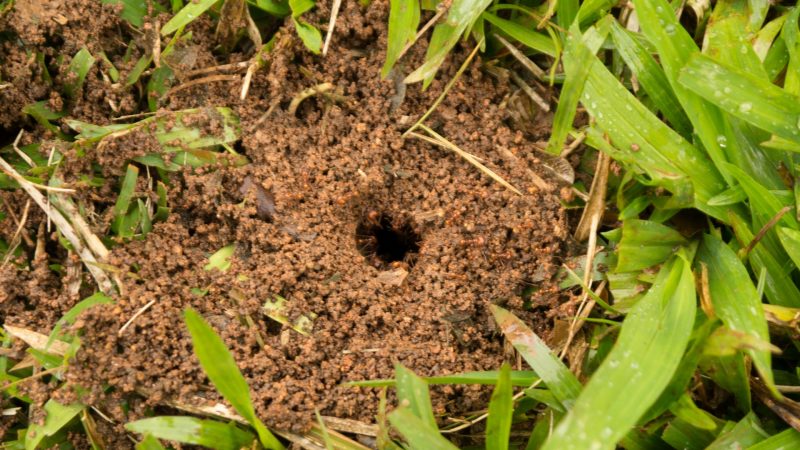
Even though considered pests in agricultural farming and residential gardening, leaf cutter ants actually play an important role in the ecosystem. By maintaining the balance of their habitats, they stimulate new plant growth and add nutrients to the soil by breaking down plant materials.
They are native to the rainforest ecosystem and it is expected that if the rainforest disappears, so will leaf-cutter ants. Interestingly enough, leaf cutter ants are responsible for 0.2%–0.7% of the CO2 emitted from the neotropical rainforest.
They also decompose their waste outside their nest which assists in to flourish “fungal garden” suppressing the growth of parasitic fungi and also helps in nitrogen fixation.
The leaf-cutter ants act as a barrier for pathogenic bacteria and fungi and suppress the growth of the microorganisms in the soil that can attack their colony. This way, these ants help in biological control and protect the environment from pathogenic microbes.
Related: Ants in Garden: Are Ants Good for Plants in Your Garden?
Are Leaf Cutter Ants Dangerous?
Leaf Cutter ants can damage your entire garden and have the potential to remove all the foliage within a single day. They swarm over trees, shrubs, or other vegetation to cut circular-shaped leaf pieces. The leaf cutter ants gather leaves during the night in the summer season whereas these ants forage during day time for the rest of the year (during spring and fall) until the rainy season.
Leaf Cutter ants can also damage pine tree needles but they prefer green foliage. During the winter season, leaf cutter ants gather pine tree seedlings when green foliage is scarce. This pest causes millions of dollars of economic losses each year in different regions of the United States.
According to recent reports, the leaf cutter ant is one of the most dominant herbivorous species in the tropics.
Leaf Cutter Ant Bite | Do Leaf Cutter Ants Sting?
In general, leaf-cutter ants do not pose any danger to humans. They might bite if you threaten them near their nesting area or if they are disturbed during their food foraging. They don’t have the ability to sting and their bites are not dangerous.
How Much Damage Do Leaf Cutter Ants Cause?
The leaf cutter ant species wreaks havoc on neighboring vegetation of almost every variety because of the massive size of a leaf cutter ant colony.The ants are busy year-round and will forage on evergreens and pine needles if necessary, even in the late fall and winter.
Although the ants are picky about the leaves they consume, they are capable of completely removing the bark off almost any tree in as little as 24 hours.
Signs of an Leafcutter Ant Infestation
Because of their activities, these ants leave an extremely visible trail. This is frequently the first indication of an infestation.
Mounds might also be present on or close to your land. Large leafcutter ant nests can have mounds that are two feet high or higher. A mature colony is challenging to overlook.
Also drawn to light are swarming ants. A mature colony is likely present nearby if you find a lot of flying reproductives close to outside lights.
How to Get Rid of Leaf Cutter Ants | Leaf Cutter Ant Control
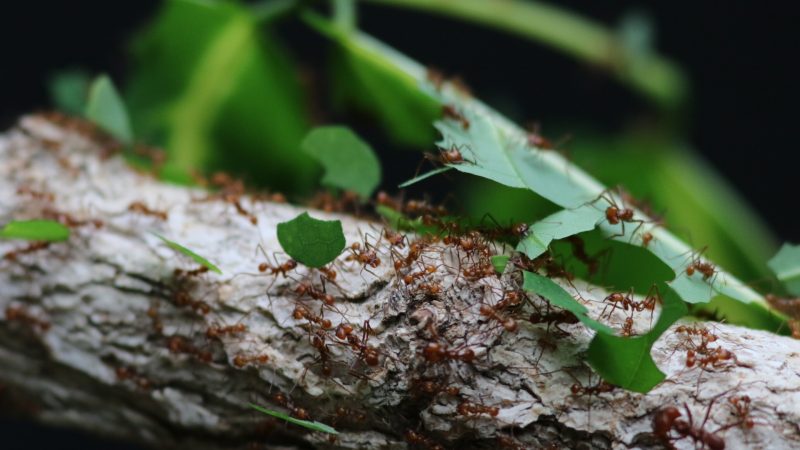
Leaf cutter ants cut and carry leaves and other vegetation to their nesting area and use them to produce fungus which they use as a source of food. Their colonies can be seen in gardens, yards, meadows, and fields. This means basically in any property with plenty of vegetation, where the soil is sandy and deep enough.
If left untreated, up to 10 million leaf cutter ants can live in a single colony which is why early identification of the mounds is very important for proper handling of the infestation.
Step 1: Inspection of the Property
Start by carefully inspecting the property. Look closely and inspect all kinds of vegetation, trees, and plants. Torn leaves and a drastic depletion of leaves are the best way to recognize a leaf cutter ant problem.
You will recognize leaf-cutter ants easily because they regularly carry pieces of vegetation. You can also spot their foraging trails, but keep in mind that in summer, the leaf cutter ants only go foraging during the night. Basically, if you find damaged plants, you have to look for their dirt mounds (colonies).
Step 2: Leaf Cutter Ant Mounds
Their nesting area can be up to a couple of hundred feet away from the damaged plants and trees. So if you find vegetation that has been eaten by leaf cutter ants, do not limit your search only to the nearby area. Inspect your property and look for foraging trails and mounds to locate and exterminate the nesting area.
Mounds are usually built in sandy soil which is easier to burrow, often close to a water source, and can vary in size, basically from 5 to 14 inches and 1 foot or more in diameter.
Step 3: Treatment Application
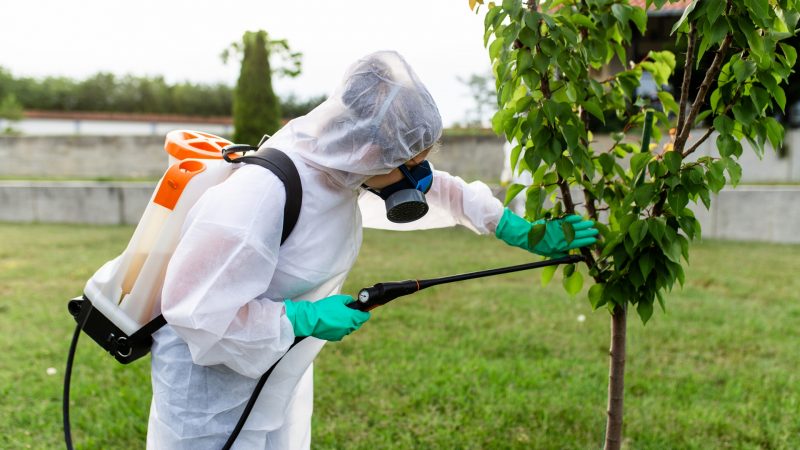
When you have found the area where you need to apply the treatment, you have to use a non-repellent insecticide. Don’t forget to always carefully read the instructions for the product of your choice and wear personal protective equipment.
Use the insecticide to soak thoroughly the mounds and spray the vegetation and trails. Spray well over and under the leaves of all the affected plants and trees, and vegetation that is near the dirt mounds. Then spray around the mound to prevent the ants from escaping, and completely soak the mound.
Step 4: Aftermath
After treatment, keep pets and people away from the area for at least 2 to 4 hours. As it is very difficult to prevent leaf cutter ants, inspect your property often to look for trails and mounds before they develop their colonies.
If these ants get out of hand they will require more effort to handle and in most cases, you will have to call professional pest control services. They will resolve your problem in no time with professional-grade chemicals.
Remember to wear personal protective equipment (PPE) before the application of insecticide in the infested area. Follow the guidelines and instructions for effective pest control.
Chemical Method
Insecticide Solution
Different insecticide solutions can be used to treat the leaf cutter ant-infested area. Locate the mounds and prepare a control solution according to the product guidelines.
First, spray the insecticide all around the diameter of the infested area to block the escape points, then directly pour the solution into the mound until it is completely drenched. Recommended pest control solutions are Dominion 2L and Conquer Liquid Insecticide Spray.
No products found.
- Description: Conquer Residual Liquid Insecticide Concentrate...
- For use In: Commercial & Residential Indoors & Outdoors:...
- Shelf life: Conquer can remain effective for 1 to 3 years in...
- Always read and follow actual package for complete label...
Insecticide Dust
Insecticidal dust is available commercially in dry powder form. The dust is directly applied to the infested area or near entry points of leaf cutter ants by using a duster. However, this is a slow process and may not work for larger infestations. The powder is hygroscopic in nature, which makes it difficult to penetrate the soil during the rainy season.
- Delta Dust Bed Bug Insecticide - 1 lb.
- Yield: 1 lb. of Delta Dust covers about 2,000 sq.ft.
- Target Pest: Ants, Bed Bugs, Boxelder Bugs, Cockroaches,...
- Active Ingredient: Deltamethrin, 0.05%
- Cannot ship to NY or CT.
Leaf Cutter Ant Baits
Baiting is also a practical and economical method that can produce effective results. The linked bait contains active ingredients that are very effective in leaf cutter ant control.
No products found.
However, this method may not be so helpful in the rainy season or near wet places. Also, it takes some time to work, and waiting for the results with leaf cutter ants can in the end prove to be detrimental.
Mechanical Method
The mechanical method is the traditional pest control method. This method comes in various forms such as grease-coated plastic tapes, plastic cylinders, aluminum strips, or metal fastened to the tree trunk to prevent plant damage.
It is not effective for highly infested areas with leaf-cutter ants and it can be applied only to small trees, shrubs, and flowering plants (not for larger fields). Cut down all the branches and leaves that are touching the ground or wall to prevent the colonization of these ants.
Cultural Control
Cultural control is one of the best methods that can be used to control leaf cutter ant infestations, especially in larger fields. According to studies, crop rotation or alternate cropping can help to reduce the chances of getting these ants. Phosphate is also reported to be effective against these pests.
The other effective technique to control this type of ant infestation is plowing. It is done within 4 months of the nuptial growth of the leaf cutter ants when the queen is about 20 cm deep below the ground. You can also combine it with pesticide treatment for effective pest control.
You can also plant repellent plants or plants that are deleterious for the leaf cutter ants. Some of the trap foods are them are the following plants such as sesame, eucalyptus, and sweet potato.
Biological Control
With biological control, you are using living organisms to control these pests. This method does not require pesticides, unlike other methods, this one is eco-friendly and non-toxic. The reported fungi that can be applied to control leaf cutter ants are Metarhizium, Paecilomyces farinosus, and Beauveria. They can reduce the leaf cutter ant population by up to 75%.
Other than fungal strains, certain birds, wasps, beetles, nematodes, and insects can also be used to control leaf-cutter ants.
How to Repel Leaf Cutter Ants: Natural Methods

It might be difficult to repel leaf cutter ants by using natural methods, but not impossible. The following are some of the natural solutions that will help in your fight against leaf-cutter ants. Because this pest is really serious we would advise you to combine both natural and chemical methods.
Insect Repellent Plants
There are several plants said to be useful against leaf-cutter ants. Introducing insect-repellent plants is one of the best techniques to avoid potential losses. This method is effective for organic farming and does not require ant killer chemicals that are toxic to vegetation as well.
One of them is lemongrass, a natural ant repellent, which can be planted across the garden, around the edges of the flower beds, and under the trees.
Another popular way is to use bay leaves. Ants do not like the smell and taste of those leaves, so you can plant several of them in your garden, or use dry leaves mixed in the mulch. You can also grind the bay leaves into powder and cover the ant mounds with it.
Also, plants that contain essential oils that interfere with their neurological system and ultimately cause their death are effective. For example, the β-eudesmol present in the Eucalyptus plant causes confusion to most pests and reduces agricultural losses.
Natural Insecticide Spray | DIY
You can prepare a non-toxic insecticide spray at home by mixing 1 tablespoon of neem oil, and 1 tablespoon of liquid soap in 10 ounces of water. Spray the insecticide solution directly on the plants and infested areas. The spray does not only kill ants but it is also effective for aphids and other insects.
Related: Best Natural Ant Sprays | Kids and Pet-Friendly Sprays
Cayenne Pepper and Baby Powder
Another home remedy is to use a mixture of equal parts cayenne pepper and baby powder to cover the ants’ trails. This will suffocate and kill them.
7 Amazing Leaf Cutter Ants Facts
- Leafcutter ants are one of the strongest creatures on Earth as they can carry up to 50 times their body weight.
- The jaws of a leaf cutter ant can vibrate 1,000 thousand times per second and create high-frequency sound waves that stiffen the leaves and make them easier to cut.
- Apart from humans, leaf-cutter ants are the only species that are able to make their own food.
- Leaf-cutter ants can turn into zombies. Parasitic Escovopsis fungus can turn them into zombies and control them.
- Leaf cutter ants are also referred to as “leaf cutting” or “parasol ants”. These are the group of ants that mostly belong to the Atta or Acromyrmex family.
- This pest causes millions of dollars of plant losses in the United States each year. It is considered to be the major pest in South and Central America.
- Each leaf-cutter ant species has the capability to cultivate a specific type of fungi.
List of Sources
Merchant M., Texas Leaf Cutting Ant, Texas A&M AgriLife Extension Service
Holbrook T., Clark R., Haney B., (2014, July 28), A Closer Look at Castes, ASU – Ask A Biologist
5 Fascinating Facts about Leaf Cutter Ants, U.S. Fish and Wildlife Service
Boyd J., Leafcutter ants’ success due to more than crop selection, Rice University
Crotteau E., Fungal Farming in Leafcutter Ants, Reed College
- How to Get Rid of Copperheads | Practical Guide - August 27, 2023
- How to Get Rid of Corn Snakes | What Makes Them Aggressive? - August 27, 2023
- How to Get Rid of Alligators | Safety Measures and Removal Methods - July 16, 2023


